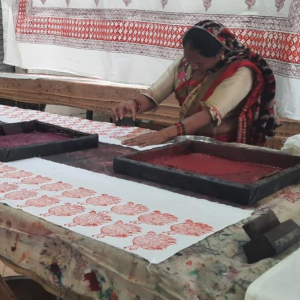
Materials for Block Printing:
Block printing is a captivating art form that allows you to create intricate and unique designs on fabric, paper, and other surfaces. To achieve the best results, it’s important to understand the material involved in the process. Here’s a detailed guide to the essential materials used in block printing, from blocks and inks to fabrics and tools.
1. Blocks
Wooden Blocks
Wooden blocks are the traditional choice for block printing. They are typically made from durable hardwoods like teak, sheesham (Indian rosewood), or sycamore. These woods are favored for their ability to withstand the pressure of printing and their capacity to hold fine details. Skilled artisans carve intricate patterns into the wooden blocks, creating reusable and enduring tools.
Linoleum Blocks
Linoleum blocks are a modern alternative to wood. They are easier to carve, making them a great choice for beginners and for designs requiring fine detail. Linoleum is flexible and can be cut into intricate shapes, providing versatility in design.
Rubber Blocks
Rubber blocks are soft and easy to carve, making them ideal for beginners or for creating more detailed designs. They are affordable and flexible, allowing for a wide range of creative possibilities.
2. Inks
Pigment Inks
Pigment inks are popular for their vibrant colors and longevity.
They are available in a wide variety of colors and are suitable for various types of fabrics.
Natural Dyes
Natural dyes derived from plants, minerals, and other natural sources, are eco-friendly and have been used for centuries. Common natural dyes include indigo, turmeric, and madder root.
Discharge Inks
Discharge inks work by removing the dye from the fabric, leaving a lighter or white design. This technique is often used on dark fabrics to create high contrast prints. Discharge inks need careful handling and are typically used by more experienced printers.
3. Fabrics
Cotton
It takes ink well and is available in various weights and weaves. Common types of cotton used include muslin, calico, and canvas.
Silk
Silk is prized for its luxurious texture and sheen. It absorbs dye beautifully, resulting in rich, vibrant prints. .
Linen
Linen is a durable, absorbent fabric with a natural, rustic texture that adds character to prints.
Rayon and Blends
These fabrics offer a balance of absorbency and durability, making them suitable for various applications.
4. Tools and Accessories
Carving Tools
Carving tools are essential for creating the design on the blocks. They come in various shapes and sizes, allowing for different types of cuts and details. Common tools include gouges, chisels, and knives.
Printing Pad or Mat
A printing pad or mat provides a soft and even surface for pressing the block onto the fabric. It helps achieve a consistent print and prevents uneven ink distribution.
Brushes and Rollers
. Brayer
It helps transfer the design evenly and ensures a crisp print.
Conclusion
Understanding the materials used in block printing is crucial to achieving beautiful and lasting results. From choosing the right type of block and ink to selecting the best fabric and tools, each component plays a vital role in the process. By carefully selecting and using these materials, you can enhance your block printing projects and explore the full potential of this creative and rewarding art form.
Embark on your block printing journey with confidence, armed with the knowledge of the best materials to use. Happy printing!



